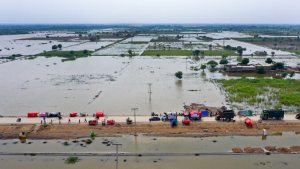NASA’s Earth Science Applied Sciences Disasters program area has partnered with the University of Hawaiʻi’s Pacific Disaster Center (PDC) and other leading scientific institutions to release a significant breakthrough in flood prediction technology to help save lives and aid early responses to rising flood impacts worldwide.
The “Model of Models” (MoM) tool combines data from open-source hydrological models with Earth-observing satellite data to generate global flood-risk severity updates several times per day. This is the first time that comprehensive global flood early warnings have been available at the sub-watershed level.

“This new technology covers the face of the globe, enabling us to observe flood risk and anticipate the likelihood of floods in ways never before possible,” said Shanna N. McClain, disasters program manager for NASA’s Earth Science Applied Sciences Program. “The technology we have developed will be transformative, enabling early action by communities around the globe—especially small island communities and developing states that lack the necessary early warning information to protect themselves and their loved ones during flood events.”
Need for early warning systems
Roughly half of the world’s countries lack adequate hazard early warning systems, according to a recent study by the United Nations Office for Disaster Risk Reduction and the World Meteorological Organization.

NASA partnered to integrate MoM into the PDC’s global multi-hazard alerting platform DisasterAWARE. When MoM detects a high likelihood of flooding in a region, DisasterAWARE sends a flood early warning notification to impacted communities, letting them quickly take the steps necessary to save lives and livelihoods. Local authorities may use this information to activate emergency response plans, order evacuations, or deploy response teams and humanitarian relief.
“Until now, comprehensive global flood early warnings have not been possible. Either due to limitations in hydrologic monitoring networks, forecast models, or expertise to operate and widely disseminate their results, especially in small and vulnerable countries. MoM will be a game changer,” said PDC Deputy Executive Director Chris Chiesa.
For the new technology to be put into use, it must reach the hands of local populations and decision-makers who need it most. The International Federation of Red Cross currently integrates all of PDC’s DisasterAWARE early warning and risk information into its Go Platform which provides its 192 national societies and more than 15 million volunteers with critical emergency needs information and the tools they need to provide adequate response.
“Our decades-long track record of innovating technologies for multi-hazard early warning, risk analysis and impact estimation makes PDC an optimal partner for receiving NASA’s new daily global flood model updates,” said PDC Executive Director Ray Shirkhodai.
PDC’s DisasterAWARE platform serves tens of thousands of disaster management and humanitarian assistance professionals worldwide and reaches millions more through PDC’s free public app Disaster Alert.
“The operational launch of this new model by the University of Hawaiʻi’s Pacific Disaster Center and the NASA Disasters flood team is not only an impressive example of what people can do when they come together to solve hard problems, but also timely and paramount to the climate-change crisis issues at hand,” said UH President David Lassner.
The business community is also able to access this new flood hazard information for supply chain and continuity of operations planning through DisasterAWARE Enterprise.
PDC was recently recognized by the United Nations for its efforts to build resilience through a multi-hazard approach—receiving the 2022 U.N. Sasakawa Award for Disaster Risk Reduction. The UH applied science and research center specializes in disaster risk reduction science and technology that supports organizations worldwide in creating a safer world.

